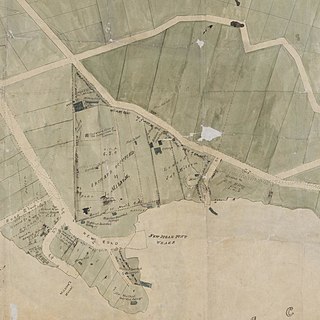
Surry, also known as Surrey, had an especially long career transporting convicts to Australia. In 11 voyages, the most of any convict transport, she brought 2,177 convicts, male and female, and so became one of the best-known of the vessels that visited Australia. In all, she lost 51 men and one woman during her various passages, 46 of the men dying during her first and most notorious voyage in 1814 when she was under the command of James Patterson.
Blenheim was built in 1834 at Jarrow, England. She made three voyages transporting convicts to Australia. She also carried emigrants to New Zealand.
Hadlow was a merchant sailing ship built in 1814 at Quebec, British North America. She made two voyages transporting convicts from England and Ireland to Australia. She plied between England, India, and Sierra Leone before being lost with all hands in 1823.
Earl Grey was a merchant ship built at Newcastle upon Tyne, England in 1835. She made four voyages transporting convicts from Great Britain to Australia.
Royal Admiral was a 414-ton timber three-masted barque, built at King's Lynn, England in 1828 and used as a merchant ship. Royal Admiral first served for trade to India. She subsequently sailed to Australia on four occasions carrying convicts, from Portsmouth to Port Jackson in 1830, from Dublin to Port Jackson in 1833 and 1834, and from Woolwich to Hobart Town in 1842.
Recovery was a merchant ship built at Batavia in 1799 and taken in prize c.1811. She made two voyages transporting convicts from England to Australia and one voyage from Ireland to Australia. She also made two voyages for the British East India Company (EIC). She was last listed in 1847.
Castle Forbes was a merchant ship built by Robert Gibbon & Sons at Aberdeen, Scotland in 1818. She made two voyages transporting convicts from Ireland to Australia. She sustained damage in 1826 on a voyage to India and was condemned at the Cape of Good Hope. She was sold there for breaking up.
Captain Cook was a 452-ton merchant ship built at Whitby, England in 1826. She made three voyages transporting convicts from Ireland and England to Australia.
Earl St. Vincent was a merchant ship built at Topsham, England in 1800. Between 1818 and 1823 she made three voyages transporting convicts from England and Ireland to Australia.
Edward was built at Bristol, England, in 1806. She was a West Indiaman until from 1829she made two voyages transporting convicts from Ireland to Australia. She was last listed in 1841, sailing between London and Madras.
Eliza was a merchant ship built in Java, Netherlands East Indies, in 1815. She was registered at Calcutta in 1818. She made two voyages transporting convicts from England to Australia. She was last listed in Lloyd's Register in 1848.
Elizabeth was a merchant ship built at Chepstow, Wales in 1809. She made three voyages transporting convicts from England and Ireland to Australia. Elizabeth is no longer listed after 1832 and may have been lost in 1831.
Eliza was a merchant ship built in British India, probably in 1804. Between 1819 and 1831 she made five voyages transporting convicts from England and Ireland to Australia. In between, she also made one voyage for the British East India Company (EIC). Her crew abandoned her at sea in 1836 as she was leaking uncontrollably.

Governor Ready was a 512-ton merchant ship built at Prince Edward Island, Canada in 1825. She made two voyages transporting convicts from England and Ireland to Australia. She was wrecked in the Torres Strait in May 1829.
Grenada was a merchant ship built at Kingston upon Hull, England in 1810. She made four voyages transporting convicts from England to Australia. In 1827, while returning to England from Australia via Batavia, she arrived at Mauritius in a damaged state and was condemned.

Isabella was a merchant ship built on the Thames, England, and launched in 1818. She made six voyages transporting convicts from England and Ireland to Australia. In between, she made one round trip to China for the British East India Company (EIC). From her launch to 1834 she was a Licensed Ship; that is, she traded with India and the Far East under a license from the EIC. From 1848 on served in the North America trade. She is last listed in 1850.
Henry was a sailing ship built in 1819 at Quebec, Canada. She initially sailed between London and Quebec, but then she made two voyages transporting convicts from England to Australia. She was wrecked in the Torres Strait in 1825.
Henry Wellesley was a 304-ton barque sailing ship built in 1804 by Bacon, Harvey & Company at Calcutta, British India. She was wrecked near Calais in 1841.
York was a sailing ship built in 1819 at Southwick. She made one voyage to Bombay for the British East India Company (EIC) in 1820. She made three voyages transporting convicts to Australia between 1829 and 1832. She was condemned and sold for breaking up in 1833 at Mauritius.
James Pattison was a merchant sailing ship built in 1828 upon the River Thames, England. She made one voyage for the British East India Company (EIC), and two transporting convicts to New South Wales. She also carried immigrants. She burnt to the waterline after her cargo ignited en route from Sydney to England in 1840.






